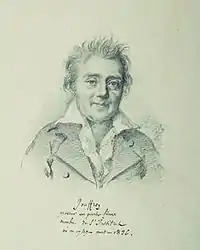Romain-Vincent Jeuffroy
Romain-Vincent Jeuffroy (16 July 1749 – 2 August 1826) was a French gemstone engraver and medalist.[1] He was active before and during the French Revolution and the First French Empire, and made many medals for Napoleon.[2]
Romain-Vincent Jeuffroy | |
|---|---|
 Portrait by Julien-Léopold Boilly | |
| Born | 16 July 1749 Rouen, France |
| Died | 2 August 1826 (aged 77) Bas-Prunay, near Saint-Germain-en-Laye, France |
| Nationality | French |
| Occupation | Engraver |
Life

Romain-Vincent Jeuffroy was born on 16 July 1749 in Rouen.[3] He learned his art without a master, imitating an engraved stone that had come into his hands. He made his own tools. He became known, and was sponsored to go to Rome to perfect his art.[4] In 1770 Jeuffroy went to Rome and then to Naples, where he lived for ten years. He worked with Johannes Pichler.[3] He produced many engraved or embossed works, including much work for the French ambassador, the Marquis Jean-Baptiste-Charles-François de Clermont-d'Amboise.[5]
After returning to France he made Paris his home.[4] After Jacques Guay (1715–1787) stopped working, Charles-Claude Flahaut de la Billaderie (1730–1809) tried to revive gemstone engraving. He promised to give the work to Jeuffroy, but did not keep his engagement.[5] Jeuffroy engraved several portraits, which made his reputation. In 1790 he accepted an offer from King Stanislaus II of Poland and moved to Warsaw.[5]
Jeuffroy returned to Paris and was appointed a member of the Institut de France in 1803.[5] He created a commemorative medal for Napoleon entitled "The Treaty of Amiens Broken by England, May 1803".[6] Jeuffroy was made a Knight of the Legion of Honour.[7] In 1805 Napoleon founded a school of gemstone engraving, headed by Jeuffroy.[8] The school was established in the deaf-mute institution.[9] In 1816 Jeuffroy was made a member of the Académie des Beaux-Arts in the engraving section.[4]
Jeuffroy died on 2 August 1826 in Bas-Prunay near Saint-Germain-en-Laye at the age of 77.[3] Pierre-Amédée Dupaty, the medal engraver and sculptor, was one of his pupils.[10] Nicolas-Pierre Tiolier, who became the official engraver of coins, was another pupil.[11]
Work

Jeuffroy made masterpieces in his genre, particularly the heads of women.[4] His portrait subjects include the King of Poland, Prince Lubomirski and Julie Clary, Queen Consort of Naples.[5]
Gemstone engravings
- Head of Jupiter
- Louis XVI
- Marie Antoinette
- Military piety
- Love floating on his quiver
- Head of Regulus.
- Angel worshiping
- Medusa
- The genius of Bacchus
- Victor drinking from a cup
- Bacchante
Medals
- The Dauphin
- Fourcroy
- Madame d'Epremesnil
- Mirabeau
- Dancarville
- Mme. Regnault de Saint-Jean d'Angely
- Mme. Cosway
- The conquest of Hanover
- Peace of Amiens
- Coronation of Napoleon
- Bonaparte armed.
- Capitulation of Spandau and Magdeburg.
- Death of Louis XVII.
- Accession of Louis XVIII, March 20.
- Petrarch.
- Heads of the three consuls.
- Venus de Medici.
- The Temple prison.
- Medal of the Legislature.
- Seal of the Legion of Honor.
References
- Forrer, L. (1907). "Jeuffroy, Romain Vincent". Biographical Dictionary of Medallists. Vol. III. London: Spink & Son Ltd. pp. 71–75.
- Forrer, L. (1923). "Jeuffroy, Romain Vincent". Biographical Dictionary of Medallists. Vol. VII. London: Spink & Son Ltd. pp. 479–480.
- Tassinari 2013, p. 35.
- Hossard & Delmas 2013.
- Dussieux 1850, pp. 390–391.
- Hernon 2013, p. 359.
- Hennin 1826, p. 647.
- Bourhis 1989, p. 129.
- Pradier 1984, p. 5.
- Schwartz, Steiner & Sénéchal 2005, p. 330.
- Webb 1907, p. 259.
Sources
- Bourhis, Katell Le (1989-01-01). The Age of Napoleon: Costume from Revolution to Empire, 1789–1815. Metropolitan Museum of Art. ISBN 978-0-87099-571-2. Retrieved 2014-08-20.
- Dussieux, L. (1850). Les Artistes français à l'étranger. Paris: Gide et J. Baudry.
- Hennin, Michel (1826). Histoire numismatique de la Revolution française: ou description raisonnée des médailles, monnaies, et autres monumens numismatiques relatifs aux affaires de la France, depuis l'ouverture des états-généraux jusqu'a l'établissement du gouvernement consulaire. Merlin. Retrieved 2014-08-20.
- Hernon, Ian (2013-08-01). Fortress Britain: All the Invasions and Incursions Since 1066. History Press Limited. ISBN 978-0-7524-9717-4. Retrieved 2014-08-20.
- Hossard, Nicolas; Delmas, Bruno (2013-12-30). "JEUFFROY Romain, Vincent". Le comité des travaux historiques et scientifiques. Retrieved 2014-08-20.
- Pradier, James (1984). Correspondance. Librairie Droz. ISBN 978-2-600-03603-0. Retrieved 2014-08-20.
- Schwartz, Emmanuel; Steiner, George; Sénéchal, Philippe (2005). The Legacy of Homer: Four Centuries of Art from the Ecole Nationale Supérieure Des Beaux-Arts, Paris. Dahesh Museum of Art. ISBN 978-0-300-10918-4. Retrieved 2014-08-20.
- Tassinari, Gabriella (2013). "Jeoffroy, Romain Vincent". Allgemeines Künstler Lexikon. Vol. 78. Berlin/Boston: De Gruyter. Retrieved 2014-08-20.
- Webb, Percy (1907). The Reign and Coinage of Carausius. Рипол Классик. ISBN 978-5-88181-419-9. Retrieved 2014-08-17.
External links
- Romain-Vincent Jeuffroy in American public collections, on the French Sculpture Census website